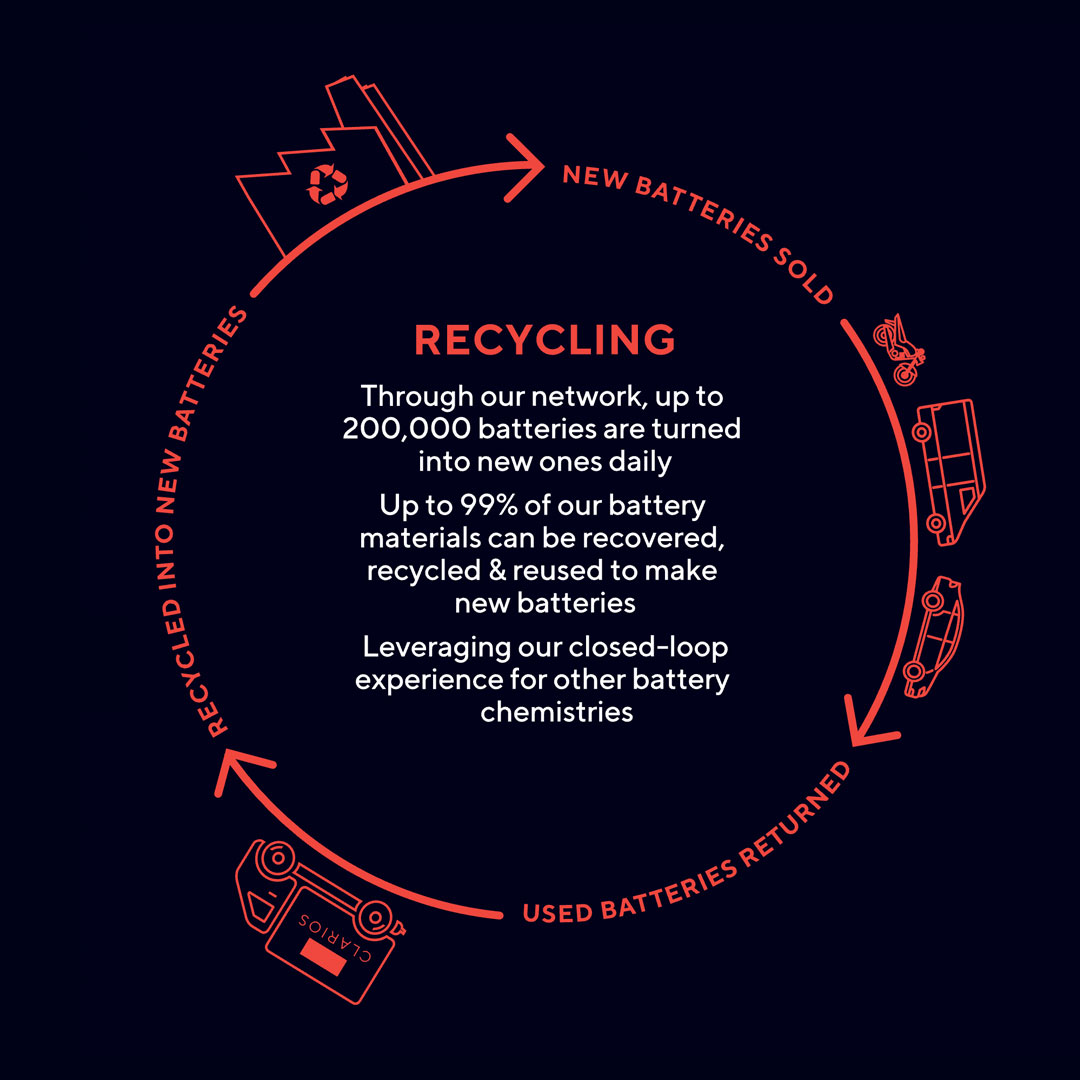MOBILITÄT IM WANDEL: WIE NIEDERSPANNUNGSBATTERIE-ARCHITEKTUREN ZUR ENTWICKLUNG DES SOFTWAREDEFINIERTEN FAHRZEUGS BEITRAGEN

Autor: Federico Morales-Zimmermann, Group Vice President und General Manager, Original Equipment & Technology bei Clarios
In den kommenden zehn Jahren wird sich die Fahrzeugtechnik stärker verändern als im vergangenen Jahrhundert, angetrieben von beispiellosen Fortschritten in Technologie und Nachhaltigkeit. Dieser Wandel betrifft nicht nur die Fahrzeuge selbst, sondern auch das Herzstück ihres Antriebs: die Batterien.
Jedes Fahrzeug, ob mit Verbrennungs-, Hybrid- oder Elektroantrieb, benötigt eine Niederspannungsstromquelle
Beim Thema Autobatterien denken viele Menschen heute sofort an die großen Lithium-Ionen-Batterien, die in Elektroautos zu finden sind. Doch das ist nur ein Teil des Ganzen. Fahrzeuge – solche mit vollelektrischem Antrieb eingeschlossen – benötigen eine Stromquelle zum Starten, für Beleuchtung und Armaturen sowie für Sicherheits- und autonome Funktionen. Diese Niederspannungsbatterien sind das Rückgrat des elektrischen Systems in modernen Fahrzeugen. Und mit Blick auf die Zukunft spielen sie eine immer wichtigere Rolle.
So enthalten die führenden Luxuslimousinen von heute oft nicht nur eine Niederspannungsbatterie, sondern in manchen Fällen sogar drei. Diese Niederspannungsbatterien versorgen automatische Tempomat-Systeme, Over-the-Air-Software-Updates und bieten Speicherlösungen für die beim regenerativen Bremsen gewonnene Energie. Wir bei Clarios unterstützen die Bedürfnisse unserer Kunden im Bereich der Niederspannungssysteme und sind begeistert, in welche Richtung sich die Technologie entwickelt.
Clarios ist der weltweit führende Anbieter von Niederspannungsbatteriesystemen für softwaredefinierte Fahrzeuge
Fahrzeuge entwickeln sich von mechanischen Maschinen zu komplexen, softwaredefinierten Systemen. Bis 2030 werden Autos über 300 Millionen Zeilen Programmiercode umfassen – ein deutlicher Sprung gegenüber 100 Millionen Zeilen im Jahr 2020, ganz zu schweigen von den 1970er-Jahren, als Fahrzeuge noch praktisch ohne Code auskamen. Dieser Wandel erfordert eine innovative Niederspannungsarchitektur, die in der Lage ist, die Komplexität und den Leistungsbedarf moderner Automobile zu bewältigen.
Clarios hat sich ein klares Ziel gesetzt: die Entwicklung und den Ausbau von Multi-Batteriesystemen. Diese Systeme sollen nicht nur Fahrzeuge antreiben, sondern auch deren immer anspruchsvollere Funktionen unterstützen. Auch als Weltmarktführer sind wir uns bewusst, dass wir unsere Kenntnisse und Fähigkeiten im Interesse unserer Kunden stetig erweitern müssen. Ein Beispiel dafür, wie wir unsere Fähigkeiten in den Bereichen Software, Elektronik und Systemintegration ausbauen und damit den Fortschritt sowohl intern als auch kundenseitig beschleunigen, ist die jüngst erfolgte Übernahme der Batteriesparte von Paragon in Deutschland.

Die Entwicklung von mechanischen zu elektrischen Systemen erhöht die Bedeutung des Niederspannungsnetzes und entsprechender Batterien und führt zur Herausbildung einer softwaredefinierten Niederspannungsarchitektur. Angesichts der Herausforderungen, mit denen Erstausrüster durch immer komplexere und anspruchsvollere Systeme konfrontiert sind, braucht es unbedingt ein präzises Verständnis elektrischer und elektronischer Architekturen, um optimale Lösungen entwickeln und anbieten zu können.
Elektrifizierung und Digitalisierung ermöglichen softwaredefinierte Fahrzeuge
Da die Transformation von mechanischen zu elektrischen Fahrzeugsystemen voranschreitet, werden redundante Stromversorgungslösungen immer wichtiger. Automobilhersteller entwickeln derzeit Technologien wie Steer-by-Wire, Brake-by-Wire und aktive Fahrwerkskomponenten, die die Fahrzeugleistung erhöhen, das Gewicht reduzieren und die Effizienz steigern. In diesen Veränderungen spiegeln sich Technologien wider, die wir bereits aus der modernen Luftfahrt kennen: sicherheitsrelevante Doppelbatteriesysteme. Bei Clarios erweitern wir unser Angebot um solche Multi-Batterienetzwerke und integrieren Superkondensatoren zur Verbesserung unserer Niederspannungslösungen.
Dabei arbeiten wir mit Automobilherstellern zusammen, bieten fortschrittliche Niedervolt-Batterielösungen an und leisten Pionierarbeit im Bereich der Kreislaufwirtschaft für Autobatterien, was uns zu einem führenden Anbieter nachhaltiger Batterieinnovationen macht. Wir bereiten uns nicht nur auf die Zukunft vor, sondern gestalten sie aktiv – mit unserem umfassenden, integrierten Ansatz für Niederspannungssysteme.
Ein materialunabhängiger Ansatz für Fahrzeugbatterien
Nicht jede Batterie, die in Fahrzeugen zum Einsatz kommt, ist gleich. Im Gegenteil, Fahrzeugbatterien können auf ganz unterschiedlichen chemischen Reaktionen und Materialien basieren, darunter Lithium-Titanat (LTO), Lithium-Eisenphosphat (LFP), Nickel-Mangan-Kobalt (NMC), Natrium-Ionen und Bleisäure. Klingt kompliziert? Ist es auch, zumindest im Detail. Letztlich genügt es aber, zu wissen, dass diese verschiedenen Materialien Batterien mit unterschiedlichen Eigenschaften ergeben. Einige Batterien laufen besonders lange, andere haben kürzere Laufzeiten, aber dafür mehr Leistung, wieder andere sind schwerer und manche werden von der Außentemperatur beeinflusst. Was die Herstellung von Fahrzeugbatterien angeht, ist keine Technologie „besser“ oder „schlechter“, denn es kommt immer auf die Anwendung an.
Unser Ansatz ist materialunabhängig – das heißt, wir können mit jeder chemischen Zusammensetzung arbeiten. Dies gewährleistet Flexibilität und Anpassungsfähigkeit, sodass wir Kunden genau das liefern können, was sie für ihr Fahrzeug benötigen. Diesem Ansatz fühlen wir uns verpflichtet und dies war auch der Ansporn für unsere kürzlich angekündigte Zusammenarbeit mit Altris. Dieses schwedische Unternehmen ist auf Natrium-Ionen-Technologie spezialisiert und hilft uns bei der Entwicklung einer Natrium-Ionen-Batterielösung für den Automobilsektor. Unsere Zusammenarbeit mit Altris ist ein entscheidender Schritt in unserem technologieunabhängigen Vorgehen. Durch diese Partnerschaft stehen wir an der Spitze der Entwicklung von Niedervolt-Batterien mit Natrium-Ionen-Technologie, die besonders nachhaltig ist, da sie auf wiederverwertbaren Stoffen wie Salz, Holz, Eisen und Luft aufbaut.
Die Natrium-Ionen-Technologie bringt bekanntermaßen einige technische Herausforderungen mit sich, aber unsere Zusammenarbeit zielt darauf ab, diese Hindernisse zu überwinden. Durch Nutzung der zahlreichen Vorteile dieser Technologie – darunter die reichliche und einfache Verfügbarkeit der Ausgangsstoffe – arbeiten wir auf eine neue Generation von Niederspannungsbatterien hin, die nicht nur kostengünstig, sondern auch nachhaltiger sind.
Der Clarios-Vorteil: ein fortschrittlicher Ansatz für Niederspannungssysteme
Unser fortschrittlicher Ansatz für Niederspannungssysteme ist allumfassend. Wir integrieren Chemie, Elektronik, Software und Diagnostik, um unabhängig von den Spannungsanforderungen die besten Lösungen anbieten zu können. Dank unserer globalen Präsenz sind wir in der Lage, unsere breite Produktpalette, einschließlich 12- bis 48-Volt-Lösungen, an Kunden aus dem Ersatzteilmarkt und der Erstausrüstung in aller Welt zu vertreiben.

Kreislaufwirtschaft und Nachhaltigkeit sind in der DNA von Clarios verankert und prägen unseren Ansatz von der Konzeption und Produktentwicklung bis hin zur Produktion. Wir sind bestrebt, Lösungen im Sinne der Kreislaufwirtschaft anzubieten, und machen unseren Ansatz damit in der Branche einzigartig. Mit über 150 Millionen Batterien, die wir jedes Jahr weltweit an unsere Kunden ausliefern, wollen wir auch weiterhin die Transformation im Bereich der Autobatterien anführen und dazu beitragen, dass zukünftige Fahrzeuge mit effizienten, nachhaltigen und sicheren Multi-Batteriesystemen betrieben werden.